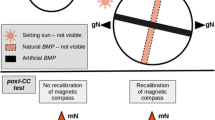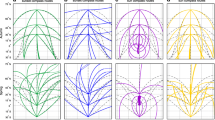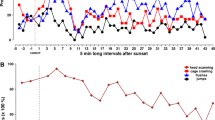Abstract
Migratory birds use both geomagnetic and celestial cues to select and maintain their seasonally appropriate migratory direction. The integration of the different compass cues is still poorly understood. Previous cue-conflict experiments suggested that Pied Flycatchers Ficedula hypoleuca did not recalibrate their magnetic compass against the polarization pattern at twilight, but the available evidence is problematic given the high variability of birds’ directional preferences. We performed a new set of cue-conflict experiments where (1) we modified the protocol in order to try to reduce scatter of data and (2) we integrated the results of two experimental approaches, i.e. orientation cages and releases of radio-tagged birds. Pied Flycatchers were tested in Emlen funnels without access to celestial cues before and after being exposed to conflicting visual and geomagnetic information. After the second test, birds were equipped with radio-transmitters and followed until the vanishing of the radio signal. Contrary to previous experiments, our data showed a general dominance of celestial cues: polarized light sun-related pattern in captive birds tested without access to stars and stellar dominance in free-flying birds released under a starry sky at night-time. These results underline the importance of experimental protocols when testing ways in which birds integrate their compass systems.
Zusammenfassung
Neue Experimente mit widersprüchlichen Signalgebern deuten auf eine Führungsrolle visueller Signalgeber bei der Zugorientierung von Trauerschnäppern Ficedula hypoleuca hin Zugvögel nutzen sowohl geomagnetische als auch Himmelssignalgeber, um die der Jahreszeit entsprechende Zugrichtung zu wählen und einzuhalten. Die Integration der verschiedenen Kompasssignalgeber ist nach wie vor kaum verstanden. Vorherige Experimente mit widersprüchlichen Signalgebern deuteten darauf hin, dass Trauerschnäpper Ficedula hypoleuca ihren Magnetkompass nicht anhand des Abenddämmerung-Polarisationsmusters rekalibrieren, doch die vorliegenden Befunde sind in Anbetracht der hohen Variabilität der Richtungspräferenzen von Vögeln problematisch. Wir haben einen neuen Satz von Experimenten mit widersprüchlichen Signalgebern durchgeführt, in dem wir (1) das Protokoll modifiziert haben, in dem Versuch, die Streuung der Daten zu reduzieren, und (2) die Ergebnisse zweier experimenteller Ansätze, Orientierungskäfige und Freilassung von mit Radiosendern versehenen Vögeln, integriert haben. Trauerschnäpper wurden in Emlen-Trichtern ohne Zugang zu Himmelssignalgebern getestet, bevor und nachdem sie widersprüchlicher visueller und geomagnetischer Information ausgesetzt worden waren. Nach dem zweiten Test wurden die Vögel mit Radiosendern versehen und solange verfolgt, bis das Radiosignal verschwand. Im Gegensatz zu vorherigen Experimenten zeigten unsere Daten eine generelle Dominanz von Himmelssignalgebern–das Polarisationsmuster des Tageshimmels bei Vögeln in Gefangenschaft, die keinen Zugang zu den Sternen hatten, und Sterne bei Vögeln, die nachts bei sichtbarem Sternenhimmel freigelassen wurden. Diese Ergebnisse unterstreichen die Bedeutung experimenteller Protokolle, wenn untersucht wird, wie Vögel ihre verschiedenen Kompasssysteme integrieren.



Similar content being viewed by others
References
Able KP (1990) Comparison of vanishing bearings, orientation directions and ringing recoveries of spring migrant white-throated sparrows, Zonotrichia albicollis. J Ornithol 131:317–323
Able KP, Able MA (1990) Ontogeny of migratory orientation in the Savannah sparrow, Passerculus sandwichensis: calibration of the magnetic compass. Anim Behav 39:905–913
Adams DC, Anthony CD (1996) Using randomization techniques to analyse behavioural data. Anim Behav 51:733–738
Agostinelli C, Lund U (2013) R package ‘circular’: Circular Statistics (version 0.4-7). https://r-forge.r-project.org/projects/circular/
Barron DG, Brawn JD, Weatherhead PJ (2010) Meta-analysis of transmitter effects on avian behaviour and ecology. Methods Ecol Evol 1:180–187
Batschelet E (1981) Circular statistics in biology. Academic, New York
Chernetsov N, Kishkinev D, Kosarev V, Bolshakov CV (2011) Not all songbirds calibrate their magnetic compass from twilight cues: a telemetry study. J Exp Biol 214:2540–2543
Cherry JD, Able KP (1986) An alternative method for the analysis of Emlen funnel data. Auk 103:225–227
Cochran WW, Mouritsen H, Wikelski M (2004) Migrating songbirds recalibrate their magnetic compass daily from twilight cues. Science 304:405–408
De Santis A, Gaya-Piqué L, Dominici G, Meloni A, Torta JM, Tozzi R (2003) Italian Geomagnetic Reference Field (ITGRF): update for 2000 and secular variation model up to 2005 by autoregressive forecasting. Ann Geophys 46:491–500
Emlen ST, Emlen JT (1966) A technique for recording migratory orientation of captive birds. Auk 83:361–367
Gaggini V, Baldaccini N, Spina F, Giunchi D (2010) Orientation of the Pied Flycatcher Ficedula hypoleuca: cue-conflict experiments during spring migration. Behav Ecol Sociobiol 64:1333–1342
Kaiser A (1993) A new multi-category classification of subcutaneous fat deposits on songbirds. J Field Ornithol 64:246–355
Liu X, Chernetsov N (2012) Avian orientation: multi-cue integration and calibration of compass systems. Chinese Birds 3:1–8
Marchetti C, Zehtindjiev P (2009) Migratory orientation of sedge warblers (Acrocephalus schoenobaenus) in relation to eating and exploratory behaviour. Behav Process 82:293–300
Moore BR (1980) A modification of the Rayleigh test for vector data. Biometrika 67:175–180
Mouritsen H (1998) Redstarts, Phoenicurus phoenicurus, can orient in a true-zero magnetic field. Anim Behav 55:1311–1324
Mouritsen H, Larsen ON (1998) Migrating young Pied Flycatchers Ficedula hypoleuca do not compensate for geographical displacements. J Exp Biol 201:2927–2934
Muheim R (2011) Behavioural and physiological mechanisms of polarized light sensitivity in birds. Philos Trans R Soc Lond B 366:763–771
Muheim R, Jenni L (1999) Nocturnal orientation of robins, Erithacus rubecula: birds caught during migratory flight are disoriented. Acta Ethol 2:43–50
Muheim R, Jenni L, Weindler P (1999) The orientation behaviour of chaffinches, Fringilla coelebs, caught during active migratory flight, in relation to the sun. Ethology 105:97–110
Muheim R, Moore FR, Phillips JB (2006a) Calibration of magnetic and celestial compass cues in migratory birds-a review of cue-conflict experiments. J Exp Biol 209:2–17
Muheim R, Phillips JB, Åkesson S (2006b) Polarized light cues underlie compass calibration in migratory songbirds. Science 313:837–839
Muheim R, Akesson S, Phillips J (2007) Magnetic compass of migratory Savannah sparrows is calibrated by skylight polarization at sunrise and sunset. J Ornithol 148:S485–S494
Muheim R, Phillips JB, Deutschlander ME (2009) White-throated sparrows calibrate their magnetic compass by polarized light cues during both autumn and spring migration. J Exp Biol 212:3466–3472
R Core Team (2013) R: a language and environment for statistical computing. R Foundation for Statistical Computing, Vienna. http://www.R-project.org/
Sandberg R, Moore FR (1996) Migratory orientation of red- eyed vireos, Vireo olivaceus, in relation to energetic condition and ecological context. Behav Ecol Sociobiol 39:1–10
Sandberg R, Pettersson J, Alerstam T (1988) Shifted magnetic fields lead to deflected and axial orientation of migrating robins, Erithacus rubecula, at sunset. Anim Behav 36:877–887
Schmaljohann H, Becker PJJ, Karaardic H, Liechti F, Neaf-Daenzer B, Grande C (2011) Nocturnal exploratory flights, departure time and direction in a migratory songbird. J Ornithol 152:439–452
Schmaljohann H, Rautenberg T, Muheim R, Naef-Daenzer D, Bairlein F (2013) Response of a free-flying songbird to an experimental shift of the light polarization pattern around sunset. J Exp Biol 216:1381–1387
Spina F, Volponi S (2008) Atlante della Migrazione degli Uccelli in Italia. 2. Passeriformi. Ministero dell’Ambiente e della Tutela del Territorio e del Mare. Istituto Superiore per la Protezione e la Ricerca Ambientale (ISPRA), Roma
Wiltschko R, Wiltschko W (2003) Mechanisms of orientation and navigation in migratory birds. In: Berthold P, Gwinner E, Sonnenschein E (eds) Avian migration. Springer, Berlin, pp 433–456
Wiltschko R, Munro U, Ford H, Wiltschko W (2008a) Response to the comments by R. Muheim, S. Akesson, and JB Phillips to our paper “Contradictory results on the role of polarized light in compass calibration in migratory songbirds”. J Ornithol 149:663–664
Wiltschko R, Munro U, Ford H, Wiltschko W (2008b) Contradictory results on the role of polarized light in compass calibration in migratory songbirds. J Ornithol 149:607–614
Acknowledgments
We would like to thank all the people who helped us in the field (P. O’Shaughnessy, E. Scordamaglia and all ringers working in the ringing station of Ventotene Island) and A. De Santis for the measurements of the magnetic disturbance due to radio tags. The comments of two anonymous reviewers greatly improved an earlier draft of the manuscript. This work complies with the current Italian laws on animal welfare. This study was supported by the Italian Ministero dell’Istruzione, dell’Università e della Ricerca (MIUR–Prin 2008). Results from the “Progetto Piccole Isole” ISPRA: paper no. 53.
Author information
Authors and Affiliations
Corresponding author
Additional information
Communicated by H. Mouritsen.
Electronic supplementary material
Below is the link to the electronic supplementary material.
Rights and permissions
About this article
Cite this article
Giunchi, D., Vanni, L., Baldaccini, N.E. et al. New cue-conflict experiments suggest a leading role of visual cues in the migratory orientation of Pied Flycatchers Ficedula hypoleuca . J Ornithol 156, 113–121 (2015). https://doi.org/10.1007/s10336-014-1107-z
Received:
Revised:
Accepted:
Published:
Issue Date:
DOI: https://doi.org/10.1007/s10336-014-1107-z




